Silicon and Silicon Wafer Based Integrated Capacitors
- Posted by doEEEt Media Group
- On May 15, 2023
- 0
Silicon-based capacitors are typically single MIM (metal-insulator-metal) or multiple MIM structure electrostatic capacitors built by semiconductor technologies.
Silicon dielectrics are either silicon dioxide (MIS) or silicon nitride (MOS) insulating layers; however, semiconductor manufacturing techniques such as atomic layer deposition (ALD) can be used to form other dielectric materials on top of the silicon substrate. High-density silicon-based capacitors use 3D nano-structured electrodes to achieve higher surface area and, thus, higher capacitance value.
Introduction
Silicon-based dielectrics such as silicon dioxide and silicon nitride are commonly used in high-density capacitors. Capacitors with silicon dielectrics are ideal for applications that demand high stability, reliability, and tolerance to high temperatures. The performance characteristics of these capacitors make them a suitable choice for use in harsh environment applications. The following are the key strengths and limitations of silicon-based dielectrics.
Strengths of silicon-based dielectrics
High stability at high temperature
The performance of most capacitors is significantly affected by exposure to high temperatures. Silicon capacitors are available in different temperature ratings, usually up to 250oC. High-temperature silicon capacitors are suitable for various harsh environment applications, including aircraft engine controls, avionics systems, automotive systems, downhole oil exploration systems, military applications, etc. In addition, silicon capacitors offer highly stable capacitance performance as a function of voltage and temperature. Although the maximum capacitance of silicon capacitors is limited, they do not suffer ageing of capacitance. Moreover, unlike X7R and X8R capacitors, the reliability and capacitance of silicon capacitors are not degraded under DC bias conditions.
High potential for miniaturisation
Silicon-based dielectrics are commonly used in the fabrication of high-density electronic devices. High-density silicon capacitors are usually fabricated in ultra-deep trenches with very low leakage current and loss factor. Passive integration connective substrate (PICS) is the most common technology for implementing high-density capacitors. This process allows the implementation of multi-chip modules (MCMs) and chip on board (COB), and it helps to realise smaller components with low power consumption. In addition, this process allows the integration of many basic functions into a single product, thereby helping to cut manufacturing costs. By employing the latest technologies, high volumetric efficiencies have been achieved. It is expected that the volumetric efficiency of silicon capacitors will continue to improve as the demand for high-performance and miniaturised components continues to grow. So far, silicon capacitors with layers that are thinner than those of multilayer ceramic capacitor (MLCC) technology have been achieved.
Leakage current stability at high temperature
Leakage current is one of the capacitor parameters that can be affected when a capacitor is subjected to high temperatures. The dielectric material is the key factor determining a capacitor’s leakage current. Overstressing the dielectric material can significantly increase the leakage current. The charging voltage and the thickness of the dielectric also have a slight effect on the leakage current of a capacitor, as compared to most high-temperature capacitors in the market, silicon capacitors have impressive leakage current-temperature characteristics. In addition, silicon-based dielectrics offer impressive insulation resistance, making them an unmatched choice for coupling, blocking, and timing circuits.
Low failure rate
Capacitors find a wide range of applications in electronic circuits. As such, they are one of the electronic systems’ most common passive components. The reliability of a capacitor is a factor in its failure rate. Compared to other passive components, capacitors have a higher failure rate. Some of the key factors that determine the failure rate of a capacitor include operating time and loading conditions. Comparative reliability tests have shown that high-temperature silicon capacitors have better FIT (failure in time) rates as compared to high-temperature X8R capacitors.
Limitations of silicon-based dielectrics
Limited maximum capacitance
Although silicon capacitors have impressive characteristics, including high stability at high temperature, very low leakage current, high insulation resistance, and high capacitance density, there is a limit to the maximum capacitance that can be achieved. It is expected that the latest advancements in technology will help to overcome this technological limitation. In addition to improving the fabrication process, manufacturers are exploring alternative dielectrics as a solution to the major technical barriers associated with silicon-based dielectrics.
Charge leakage
SiO2 is commonly used in the fabrication of capacitors for microelectronics devices. These capacitors are constructed by oxidizing silicon and using the oxide as the dielectric material. Since capacitance is directly proportional to the area of the dielectric material and inversely proportional to the thickness of the dielectric, manufacturers of electronic devices have been decreasing the area and thickness of the dielectric material to obtain miniaturized and high-density devices. As the thickness of the SiO2 dielectric film is decreased, the charge leakage through the dielectric material increases. Beyond a certain limit, it becomes difficult for the capacitor to store charge due to the leakage problem. Although DRAM manufacturers are using deep trenches to overcome leakage problems, the dielectric thickness limitation is a major barrier to the miniaturisation of microelectronic devices. Besides improving the implementation process, manufacturers are also exploring alternative dielectrics to overcome this limitation.
Silicon-Based Capacitor Structure and Features
Silicon-based capacitors are typically single MIM (metal-insulator-metal) or multiple MIM structure capacitors built by semiconductor technologies. Silicon dielectrics are either silicon dioxide (MIS) or silicon nitride (MOS) insulating layers; however, semiconductor manufacturing techniques such as atomic layer deposition (ALD) can be used to form other dielectric materials on top of the silicon substrate. High-density silicon-based capacitors use 3D nano-structured electrodes to achieve higher surface area and, thus, higher capacitance value.
Structure of semiconductors and MOS capacitor – its band gap diagrams, work functions and electron affinity concepts are beyond this article’s scope. We will focus on describing silicon-based capacitors on the market and their key features.
Silicon MIS and MOS Capacitors
Silicon-based dielectrics are used within semiconductor manufacturing processes of high-density electronic devices by semiconductor manufacturing processes. Silicon-based dielectrics for capacitor technologies are usually based on silicon dioxide (MIS) or silicon nitride (MOS) insulating layers. Figure 1. below describes a conventional MOS technology to make silicon capacitors.
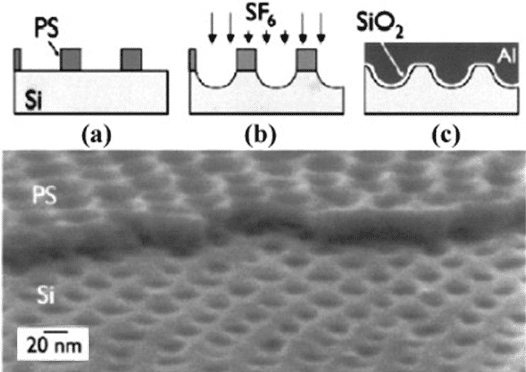
Figure 1. SEM image at a 70° tilt after RIE etch. Top shows the remaining PS template. The bottom shows nano-scale hexagonal array has been transferred into Si counter electrode; Source: App Phys Lett.
Conventional Technology MOS Capacitor Process
(a) Polymer template formation on the silicon surface
(b) RIE pattern transfer of PS template into silicon, followed by removing the PS matrix.
(c) SiO2 growth followed by top Al gate electrode deposition
Silicon capacitors can be manufactured and used as
- fully MIS/MOS compatible back-end technology as part of a passive integration platform
- hetero-integrated as Multiple-Chip-Module or flip-chip with other technologies (CMOS, MEMS, etc.) in a system in the chip (SiP) or on-chip (SoP)
- discrete chip SMD capacitors
Single Layer RF Silicon Capacitors
Silicon-based dielectrics are used to make low-loss, high-Q capacitors that feature very high-temperature stability, high breakdown voltage and low leakage parameters. The main limitation is relatively low permittivity. Comparison of MIS and MOS dielectrics – see Table 1. and Figure 2. below.


Table 1. MIS and MOS capacitor features comparison; source: AVX
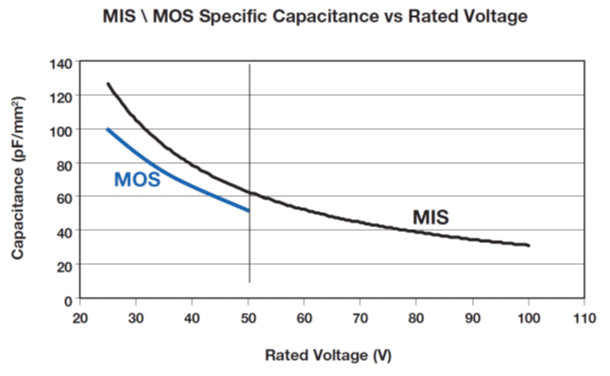
Figure 2. MIS/MOS capacitors range comparison, source: AVX
Gold or aluminum wire thermosonic and ultrasonic bonding are the most common way to assemble single-layer silicon capacitors (SLCs) in RF applications. Termination styles may differ, and it can be optimized for epoxy or solder die attach mounting techniques. Examples – see Figure 3.
Figure 3. silicon SLC capacitor mounted on RF board by wire bonding; source: Ipdia/Murata
![]()
RF Thin Film Silicon Capacitors
Silicon thin film capacitors (Figure 4.) are typically based on a single layer silicon oxide/nitride dielectric deposited on a substrate and packed in a chip MLCC-like design. It offers the unique ability of very low capacitance values (0.05pF) and very tight capacitance tolerances (±0.01pF). Thin film technology guarantees minimal batch-to-batch variability of parameters at high frequencies; thus, it is an ideal component for RF and microwave filters.
Figure 4. Silicon RF thin film capacitor construction; source: AVX
The term “thin film capacitors” however, relates to a wider range of thin film technologies using also other dielectrics such as ceramic or organic films deposited on various substrates types such as alumina, quartz, silicon or silicon wafer.
Thus, the distinction between “thin film”(deposited on a silicon substrate) and “silicon” capacitors is something of a marketing concession. However, significant differences exist within & among the two depending on the intended application.
Devices targeting RF tuning & matching applications tend to be low-capacitance, single-layer devices optimized for parameter stability and consistency and are commonly found in standard JEDEC package sizes.
In contrast, devices intended for power supply decoupling, broadband DC blocking, and similar applications allow larger tolerances to achieve higher specific capacitance and are more likely to be found in packaging adapted to advanced assembly methods such as wire bonding or embedding within a PCB. Regardless of the intended application, however, devices in the thin film and silicon capacitor families are premium-performance products priced accordingly, currently fetching something 5 to 5000 times the price of ceramic devices with similar capacitance and voltage ratings.
3D Silicon High-Density Capacitors
High-density silicon capacitors are usually fabricated in ultra-deep trenches to increase the surface area of electrodes. They have a very low leakage current and low loss factor. Passive integration connective substrate (PICS) is the most common technology for implementing high-density capacitors. This process allows the implementation of multi-chip modules (MCMs) and chip on board (COB), and it helps to realize smaller components with low power consumption. In addition, this process allows the integration of many basic functions into a single product, thereby helping to cut manufacturing costs. See Figure 5. on the right – 3D PICS capacitor structure.
Figure 5. 3D PICS Passive integration connective substrate silicon capacitor structure. Source: ipdia/Murata
By employing the latest 3D technologies, high volumetric efficiencies above 450nF/mm2 have been achieved. Silicon capacitors can be manufactured in layers below 100um that are 4xthinner than those of multilayer ceramic capacitor (MLCC) technology. Manufactured of silicon capacitors claim 10x better reliability in comparison to MLCC capacitors, and in combination with ultra-high temperature stability up to 250C, the high-density silicon capacitor technology enables a number of high demanding applications in the automotive, industrial/oil drilling or aerospace/defence industry. It is expected that the volumetric efficiency of silicon capacitors will continue to improve as the demand for high-performance and miniaturised components continues to grow.
Silicon capacitors – key features
- High Q, low losses
- Thin layers sub 100um possible
- High-temperature operation (up to 250C)
- High reliability lifetime expectancy (10x better than MLCC, as example: full rated 10V continuous operation at 250°C for 50years)
- Low leakage < 30nA/mF; Higher leakage current at high temperatures (but still 1000x lower compare to the other technologies)
- No/low radiation sensitivity
- No derating required
- No catastrophic failure mode
- Low weight
- Stable performance with tight capacitance tolerances
- No piezo effect
- Non-magnetic
- Relatively low permittivity
Silicon Wafer Based Integrated Capacitors
Integrated capacitors and passives have a lot going for them. They take up less space on a PCB, they simplify design, and they can, with the right processes, shrink circuit tolerances thanks to closer component matching. The downside is that, as with semiconductors, volume is everything.
Although a common reason for keeping passive components off-chip is their size relative to that of the transistors on-die – is not worth wasting precious silicon area on devices that cost more to assemble than their materials are worth – many off-the-shelf parts rely on passives to tune filters and control loops for specific applications.
Utilization of semiconductor fabrication processes, however, has resulted in a number of new approaches towards high-density micro-capacitors. Finish company Picosun used its atomic layer deposition ALD equipment to deposit film stacks of conductive TiN and insulating dielectric Al2O3 and HfAlO3 layers into high aspect ratio trenches etched into silicon that increased capacitance density up to 1 µF/mm2. ALD deposition and 3D micro capacitor manufacturing process is shown in Figure 6. below.
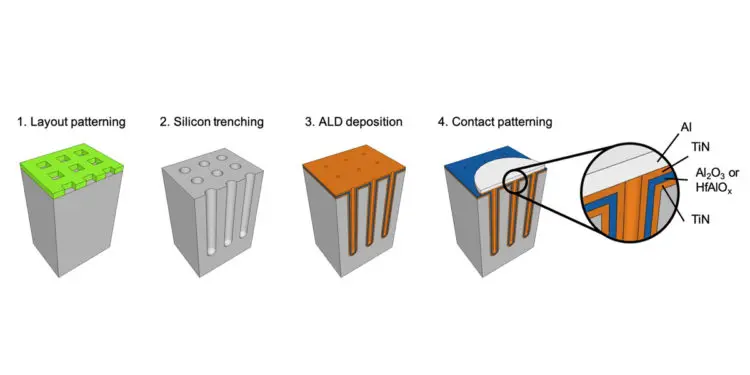
Figure 6. Main technological steps of 3D micro capacitor fabrication. 1: patterning of a square lattice of holes on the silicon surface; 2: high aspect ratio trenching of silicon by electrochemical micromachining (ECM); 3: atomic layer deposition (ALD) of conformal metal-insulator-metal (MIM) stack; 4: aluminium deposition and contact patterning. Source: Picosun
Swedish company Smoltek received Outstanding and Best Paper Awards at EPCI PCNS conference for their carbon nano-fibre metal-insulator-metal (CNF-MIM) wafer-based semiconductor technology, achieving capacitance density to +650nF/mm2 at the end of 2019. They used the ALD technique to deposit Al2O3/HfO2 layers onto a carbon nano-fibre 3D structure.
The fibre length is only 2 – 3 µm, and the total height profile of the complete device is ca 4 µm. This makes the capacitors readily available for integration onto a CMOS chip or in 3D stacking. Figure 7-9. below shows the CNFs after the dielectric coating via ALD, the image showing a coating of Al2O3/HfO2/Al2O3 (5/3/5 nm). The dielectric layer is uniformly covering the individual CNFs.
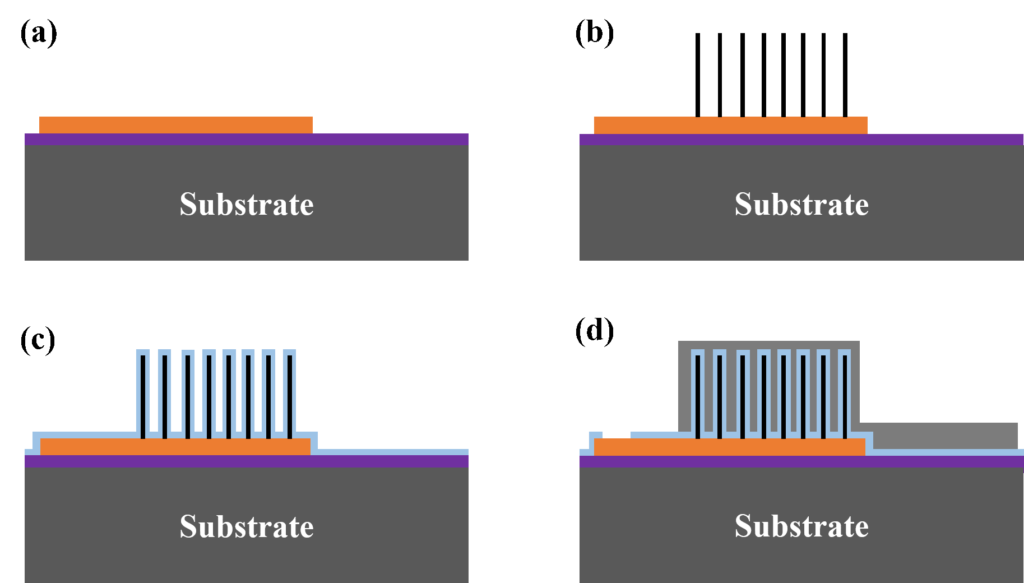
Figure 7. Schematic overview of the capacitor manufacturing process: (a) Bottom electrode formation. (b) CNF growth directly on the bottom electrode. (c) Conformal coating of dielectric material. (d) Top electrode formation and opening of dielectric for probing of bottom electrode.; source: Smoltek
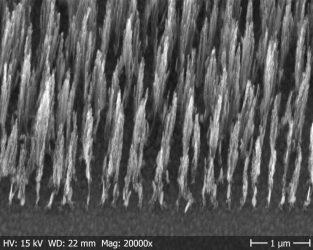
Figure 8. SEM image of the vertically aligned CNF; source: Smoltek
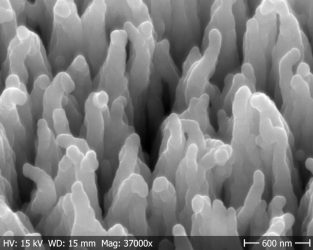
Figure 9. SEM image of the CNFs after being coated with Al2O3/HfO2/Al2O3 (5/3/5 nm) via ALD; source: Smoltek
Source: Passive Components
- Space-Grade components available for immediate delivery - April 10, 2025
- Exclusive stock on doEEEt: How to access and request - April 10, 2025
- Managing EEE components for LEO and lower cost space missions - December 17, 2024


0 comments on Silicon and Silicon Wafer Based Integrated Capacitors